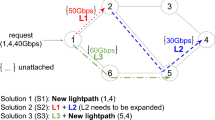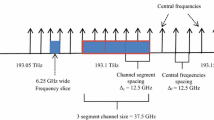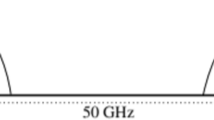Abstract
This work focusses on flexi grid elastic optical network (EON) and demonstrates high bit rate transmission. Traditional wavelength division multiplexing (WDM) technology uses fixed grid spectral spacing. Underutilization channels are avoided in flexi grid and caters to traffic demand at a high bit rate (1 Tb/s). To overcome this problem, flexi grid channel spacing is used and transmitted 400 Gb/s data rate in EON. In the proposed EON architecture, 12.5 GHz channel spacing granularity is used for channel allocation. Finally, EON channel spacing is compared with a fixed grid network.
Access provided by Autonomous University of Puebla. Download conference paper PDF
Similar content being viewed by others
Keywords
1 Introduction
System components required to establish an optical communication as shown in Fig. 1, that consists of an optical transmitter, a communication channel, and an optical receiver.
1.1 Optical Transmitter
The optical transmitter section mainly consists of the information source, data encoder, laser, and modulator. The information source is encoded before modulation as per the requirement of the modulator used in the transmitter section. Optical modulators are classified into two groups depending upon the material property.
Absorptive Modulators: In absorption, coefficient of the material is changed in this sort of modulator; it can be achieved by manipulating Franz–Keldysh effect, the quantum-confined Stark effect, excitonic absorption, changes of Fermi level, or changes of free carrier concentration. If a couple of such effects appear together, the modulator is called an electro-absorptive modulator [1].
Refractive Modulators: The refractive index of the material is changed mostly electro-optic effect is used for modulation. Some modulation takes advantage of polarization changes in liquid crystals or uses an acousto-optic effect or magneto-optic effect. This type of modulator is named depending upon the effect used, namely electro-optic modulators, acousto-optic modulators [2]. Modulated signals are multiplexed and transmitted with the help of an optical cable.
1.2 Communication Channel
The transmission medium of optical fiber will help to establish communication between two different points. Optical fiber is classified depending upon: Refractive index profile and the number of modes transmitted through the fiber. When an optical signal travels for a long distance, then the signal strength will start attenuating. Optical losses are due to various fiber characteristics such as absorption, scattering, and fiber bend losses. To overcome this issue, advanced fibers are used in addition to that Erbium-doped optical amplifier (EDFA), and dispersion compensating fibers (DCF) is used.
1.3 Optical Receiver
In receiver section, optical signal is filtered and de-multiplexed to convert optical power into electrical current that will be achieved with the help of a photodiode. After that, electrical domain filters and decoders are used to receive the transmitted information.
2 Fixed Grid and Flexi Grid
Wavelength division multiplexing (WDM) technology uses fixed grid spectral spacing [3]. WDM technology is categorized into coarse WDM and dense WDM depending upon the channel spacing. CWDM and DWDM define in ITU-T G.671 [4] and ITU-T G.694.1 [5], respectively. DWDM network has a fixed grid (channel spacing) of 50 GHz. Figure 2 shows the fixed and Flexi grid channel spacing. In the fixed grid, spectrum wastage occurs at a low bit rate and it is impossible to manage the traffic at a high bit rate (1 Tb/s). ITU-T G.694.1 frequency grids support a variety of channel spacing ranging from 12.5 to 100 GHz and wider. DWDM can be made cost-effective by incorporating Bandwidth Variable Transponder (BVT), super-channel, and flexible grid technology. To overcome the spectral efficiency problem in the fixed grid can be handled with the help flexible grid elastic optical network (EON).
Fixed grid versus flexi grid [6]
3 Elastic Optical Network (EON) Design
To design EON, it requires a few additional submodules in addition with DWDM design. The requirement of advance control planes is needed at the network level. In the same way, flex ROADMs, SBVT, super-channels, and high power amplifiers are required in the hardware level [7]. All this makes EON a little expensive, but it provides a large capacity and also helps to overcome the network traffic issues. Figure 3 shows several features and will help us define some important terms.
Elastic Optical Networking (EON): The elastic or flexible optical network refers to a system with variable bit and flexible channel spacing [7].
Bandwidth Variable Transceivers (BVTs): It handles the physical layer parameters like transmitted bit rate, transparent reach, and spectral efficiency. Multi-flow transponder assists various optical streams with various information rates running from 10 Gb∕s to 1 Tb∕s which flows multiple directions at a time.
Sliceable Bandwidth Variable Transponder: SBVT is a collection of “virtual” lower capacity bandwidth variable transceivers (BVTs) and it is a very important element in the EON to make network flexible and efficient [9]. Dynamic adaption of variable modulation format and different distance is achieved by using software control [8].
Super-Channel: It is an advancement in dense wavelength division multiplexing (DWDM) in which numerous coherent optical carriers are joined to make a bound together channel of a higher information rate and which runs in a single operation cycle [7]. DWDM channel allocation is driven by dividing optical bandwidth into equal slots of bandwidth (∆f). In EON, minimum frequency spacing is used for the channel allocation, which is given by:
A lower bound to the total optical bandwidth for the unequal channel spacing is mentioned below.
where \(B_{{{\text{eq}}}} = \left( {N - 1} \right) \times \Delta f\); N is number of channels (Small); n = minimum number of slots [9].
Modulation and Demodulation Schemes: To achieve a higher bit rate, advanced polarized modulating formats are used. Depending upon the optical reach, different modulation schemes are allocated, for example, PM-16QAM for small, PM-QPSK for medium, and PM-BPSK for large optical reach [10].
Bandwidth Variable Receiver: In the receiver side, a polarization demultiplexer is used to separate the optical signals depending upon the modulation scheme used. This block consists of different demodulators section. In this proposed work, it will segregate the two different demodulators circuits, namely PM-16QAM and PM-QPSK. After extracting the proper demodulated signal, it will drive to the digital signal processing unit for signal condition before entering to end-user.
4 EON Simulation and Result
The proposed work is realized with the help of OptiSystem™, and Fig. 4 gives clear details about the processing flow of simulation. The client interface will help to set the data rates which can be 10 Gb/s to 1 Tb/s. In our proposed elastic optical network, 400 Gb/s data is considered to transmit, and two different modulation schemes are used, namely PM-QPSK and PM-16QAM. For the realization, we consider four 100 Gb/s interface instead of one 400 Gb/s. It is hard to implement one 400 Gb/s interface practically because it requires a baud rate of nearly 100 Gbaud. That is the reason we considered 25 Gbaud with 10 GHz Guard bandwidth. That is given by channel bandwidth = spectral bandwidth + guard bandwidth (GHz).
Two different cases are considered:
-
(A)
200 Gb/s PM-16QAM modulation: In order to achieve this, two 100 Gb/s PM-16QAM modulation is used with the center frequency of 193.05 and 193.075 THz. This user demand request came from 80 km away so that PM-QAM modulation is chosen and it considers the first super-channel.
-
(B)
100 Gb/s PM-QPSK two different users: Two different requests arrived at 160 km from the source. That is the reason two different PM-QPSK modulation scheme is chosen and both combined with the central frequencies of 193.15 and 193.175 THz.
Two different super-channels are coupled and transmitted to the optical network. Table 1 gives the clear details of Dual Polarization 16QAM and Dual Polarization BPSK modulation schemes. It also gives the bit rate, sample rate, and a number of samples information.
Decision-Making Block: This particular block is used to figure out an appropriate modulation technique for the received optical signal, and it will be directed to into a suitable demodulator circuit for demodulation. Demodulator block consists of two different demodulators (PM-16QAM, PM-QPSK) circuits.
Advanced Digital Signal Processing: Low-pass filter and front-end corrections are done in this block, and in addition to that, chromic dispersion is also addressed here. At the end polarization, de-multiplexing will segregate the signal for the phase estimation and equalization and finally down-sample the signal at the receiver end.
The data rate of 200 Gb/s signal is modulated with the help of DP-16QAM, and also, taken 12.5 GHz channel spacing slots are considered. 50 GHz channel spacing is required to transmit 200 Gb/s demand. Figure 5 shows the constellation diagram of the DP-16QAM signal; it gives the clear vision of both X and Y polarization of the modulated signal. Ones it is reached to the receiver block, specific demodulated signal is extracted and passed to advance DSP for signal conditioning. Same way 100 Gb/s DP-QPSK signal is demodulated at the receiver end.
The simulating setup in OptiSystem™, optical spectra for both fixed and flexi channel spacing is observed. Figure 6 describes channel utilization of the fixed grid and flexible grid. It clearly shows that flexi grid consumes less spectrum slots for both lower and higher bit data transmissions.
5 Conclusions
The elastic optical network has been studied in detail. The super-channel technique is used to transmit a 400 Gb/s data rate. To realize this network, flexi grid channel spacing is utilized; in addition to that, advanced digital signal processing block is used for the signal conditioning. Elastic optical network gives better performance, and it uses minimum channel spacing.
References
Gupta S et al (2015) 50 GHz Ge waveguide electro-absorption modulator integrated in a 220 nm SOI photonics platform, vol 1, no c, p. Tu2A.4
Olusegun A et al (2012) We are IntechOpen, the world’s leading publisher of Open Access books Built by scientists, for scientists TOP 1%. Intech, vol i, no. tourism, p 38
Li H (2016) Network topology design
ITU (2002) ITU G.694.1 (06/2002): spectral grids for WDM applications: DWDM frequency grid
ITU-T (2012) Spectral grids for WDM applications: DWDM frequency grid. Itu-T
Imran M, Anandarajah PM, Kaszubowska-Anandarajah A, Sambo N, Poti L (2018) A survey of optical carrier generation techniques for terabit capacity elastic optical networks. IEEE Commun Surv Tutorials 20(1):211–263
Gerstel O, Jinno M, Lord A, Yoo SJB (2012) Elastic optical networking: a new dawn for the optical layer? IEEE Commun Mag 50(2)
Fischer JK et al (2014) Bandwidth-variable transceivers based on four-dimensional modulation formats. J Light Technol 32(16):2886–2895
Maharjan R, Lavrinovica I, Supe A, Porins J (2016) Minimization of FWM effect in nonlinear optical fiber using variable channel spacing technique. Adv Wirel Opt Commun 3(3):1–4
Thangaraj J (2019) Review and analysis of elastic optical network and sliceable bandwidth variable transponder architecture, vol 57, no 11
Author information
Authors and Affiliations
Editor information
Editors and Affiliations
Rights and permissions
Copyright information
© 2022 The Author(s), under exclusive license to Springer Nature Singapore Pte Ltd.
About this paper
Cite this paper
Adarsha, M., Malathi, S. (2022). Effective Utilization of Channel Spacing in Elastic Optical Network for 400 Gb/s Transmission. In: Sivasubramanian, A., Shastry, P.N., Hong, P.C. (eds) Futuristic Communication and Network Technologies. VICFCNT 2020. Lecture Notes in Electrical Engineering, vol 792. Springer, Singapore. https://doi.org/10.1007/978-981-16-4625-6_61
Download citation
DOI: https://doi.org/10.1007/978-981-16-4625-6_61
Published:
Publisher Name: Springer, Singapore
Print ISBN: 978-981-16-4624-9
Online ISBN: 978-981-16-4625-6
eBook Packages: EngineeringEngineering (R0)










